Houghton, Samuel (SCC Newsletter August 2008)
SAMUEL HOUGHTON fl.? 1783-1796
A Miers copyist or a major artist in his own right?
Some account of his work and an attempt to justify his place in the history of the art of silhouette in Britain.
Introduction
Samuel Houghton is regarded as a major silhouette artist - yet very little has been written about him. I have trawled through over a hundred articles - many written for Country Life, The Connoisseur and The Antique Collector - and I was only able to find two that illustrated works by him. In the silhouette literature, he is mentioned by the major writers such as Mrs. Jackson, Mrs. McKechnie, Desmond Coke, Arthur Mayne and Mrs. P.Hickman - but apart from Mrs. McKechnie their accounts are brief and often inaccurate. Unfortunately, little is known or has been 'discovered’ about Houghton's life or his working career. He died before many directories had been published and before The Census had started. Parish records have produced little on him. Added to this his works are rare and not easy to find. Looking through old sale catalogues I see only a handful of his works have appeared in the sales of the major collections, such as those of Desmond Coke, Jack Pollak, M.Christie, Mrs. McKechnie and Mrs,N.Jackson. Even a smaller number are in collections such as the Victoria and Albert Museum, the Andrews at Stonor House, and Malahide Castle in Dublin. Also, I notice that many of those that do appear have moved from one collection to another.
The similarities in his style to that of the great John Miers has further compounded his place in the history of British silhouettes. It is not impossible that some of his unlabelled works have been attributed to Miers over the years. Mrs. McK. stated that she was fairly certain that she could recognise his work - but I am not so sure that we lesser mortals can be so confident as I intend to show!
In this article I will firstly look at what we know about Houghton and his career with illustrations of his work on ivory and plaster from the literature, sale catalogues and collections. I will then look at his work alongside that of some contemporary works of Miers for the purposes of comparison. Finally and hopefully, to come to some conclusions as to where Houghton stands in the silhouette hall of fame. I have to confess that I have always been a great fan of his work and I hope in this article to increase his fan following!
His background
It is not known when he was born, when married and whether he had any children, or even when he started painting silhouettes. He did not have a printed address on his trade labels, so the only addresses we have for him are two from the Edinburgh & Leith Directories - namely “31 South Bridge St.” and "Head of Anchor Close" - these date from the time he formed a partnership with George Bruce in 1792-1796. There is one other address handwritten on the bock of a silhouette and dated 1786 - this is 4,Brunswick St. As all these addresses are in Edinburgh it is likely that this was Houghton's hometown. Mrs. McK. thinks it is possible that he visited Glasgow but there is no evidence that he worked out of Scotland.
He died sometime in 1796 - possibly towards the end of that year, leaving a widow Agnes (nee Carchan). Her father was a carver of frames and no doubt supplied his son-in-law. George Bruce married Agnes on 7th January 1797 and had at least one son by her. She is likely to have been older than Bruce, who does not seem to have wasted any time at all after his partner's death! However, in mitigation it is possible that there were young Houghton’s to be looked after.
Houghton page 2
His Work
Mrs. McK. has entries on Houghton in Section Four (works on plaster) and Section Five ( works on ivory) She takes the view that there is sufficient 'evidence' to confirm that he was working as a silhouette artist as early as 1783 and that his early work is likely to have been on ivory rather than plaster, as he mentions jewellery first on his trade label. She thinks he started painting on plaster in about 1786, when John Miers paid a short visit to Edinburgh, where he was so successful that he decided to return for a longer stay from 1787-1788. Alter this period Miers left for London, where he remained until the end of his career. However, in spite of statements to the contrary by other writers on Houghton Mrs. McK. is certain that he was never a pupil of Miers. She bases this assertion on Miers' experience with Miss Lightfoot, when he stayed with her mother in Liverpool, and thinks he would be unlikely to want to make a repeat mistake. Interestingly, Miss Lightfoot was also in Edinburgh in 1786 trying to pass off works by Miers as her own! This rivalry and infighting is difficult to imagine happening at the present time.
George Bruce was Houghton's pupil for about a year prior to becoming his partner in 1792. The partnership lasted for four years, when the joint trade label for Houghton & Bruce was used. Arthur Mayne describes Bruce as a jeweller and frame maker - if this is so, he was clearly a useful person to have in the business.
Works backed with S.Houghton's label painted on plaster
Men
 On the left above is Mr. Dale - ex. Kilner Collection. He rather proves my point about works by Houghton moving between the Collections. He is illustrated in Mrs. McK's Book on page 648 illus. 1255. He is nicely painted and portrayed with his queue and frill well defined.
On the left above is Mr. Dale - ex. Kilner Collection. He rather proves my point about works by Houghton moving between the Collections. He is illustrated in Mrs. McK's Book on page 648 illus. 1255. He is nicely painted and portrayed with his queue and frill well defined.
On the right is Mr. Ronald ex. Mrs. McK's Collection and sold at her Sale on 30th. July, 1979 lot 120. Also, he is illustrated in her Book together with an enlargement of his shirt frill on page 649 illus. 1259. For many years he has been described as being "in poor condition" unfortunately. I do not know his present whereabouts, but hope he is as 'well’ as can be expected!
Houghton page 3
More Men
 On the left is an unknown man ex. Christie Collection - he is taken from a photograph in Mrs. McK's archives. There are shadows on the bow of his queue which will be shown in detail later. Houghton is said to have copied the shadowing from John Miers - although it is not seen very often on the extant works of Houghton .
On the left is an unknown man ex. Christie Collection - he is taken from a photograph in Mrs. McK's archives. There are shadows on the bow of his queue which will be shown in detail later. Houghton is said to have copied the shadowing from John Miers - although it is not seen very often on the extant works of Houghton .
In the centre is a man - from his appearance he could be taken for an early work of Miers and I think was probably one of Houghton's first 'attempts' on plaster! He shows very little detail of any kind but neverthess is quite a pleasing work of the period. He is housed in a pressed brass frame.
On the right is another unknown man sold at Sotheby’s on 20th July 1981 lot 10. Strangely he is housed in a papier mache frame surmounted with a duel crown -this framing is unusual fur Houghton and it nu. have been a special request or he has been reframcd at a later date. He may have been an important person but his name has been ‘lost' Note the slight differences in the bust-line termination on all three.
Women
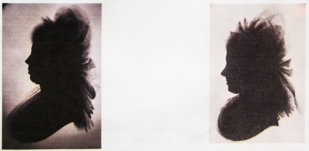 On the left Is Mrs.Bell - she was sold with her husband at Sotheby's on 14th Detember 1981 lot 20 - both were illustrated In the catalogue. Mr. Bell is part of a different collection and I hope the pair will be reunited at some point! She is wearing a be-ribboned cap, over her loose curls, which I will show in more detail later.
On the left Is Mrs.Bell - she was sold with her husband at Sotheby's on 14th Detember 1981 lot 20 - both were illustrated In the catalogue. Mr. Bell is part of a different collection and I hope the pair will be reunited at some point! She is wearing a be-ribboned cap, over her loose curls, which I will show in more detail later.
On the right is an unknown lady sold in the Patten Sale at Bonhams on 21st November 1997 lot 31 Also, she is illustrated in the Book on page .9 illus. 1256 interestingly she made £950 on the hammer - in spite of this the purchaser reported that she needed quite a lot of tidying-up and that Sellotape, had been used to secure her frame! I do not think she would have made this price at the present time.
Houghton Page 4
More Women
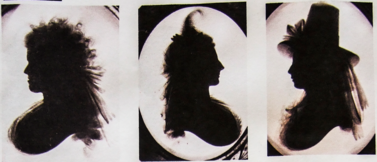 On the left is Francis Yates - a well-known example of Houghton's work. She is ex Mrs. McK's Collection and was sold at her Sale on 30th July 1979 lot 119. Also, she is illustrated in the Book on page 649 illus. 1257 together with an enlargement of her ribbons and hair to show Houghton's particular style with these (page 677 illus. 1421.)
On the left is Francis Yates - a well-known example of Houghton's work. She is ex Mrs. McK's Collection and was sold at her Sale on 30th July 1979 lot 119. Also, she is illustrated in the Book on page 649 illus. 1257 together with an enlargement of her ribbons and hair to show Houghton's particular style with these (page 677 illus. 1421.)
In the centre is an unknown rather showy lady sold at Sotheby's on 26th. April 1971 lot 47. Note her verre eglomise surround, which is in Houghton's special design and could provide a useful attribution 'tool'. More detail later!
On the right is an unknown woman. I think she is a wonderful example of Houghton's work and she provided the 'inspiration' for this article! I think Houghton shows her costume well if not with quite the detail that Miers would have shown in his heyday.
Children
 Houghton's skills and his artistic qualities are particularly evident in his work with young people - both on ivory and plaster. I think these works are more easily recognised as being the work of Houghton than many of those of older people. They have been described in the literature as being sensitive and attractive in their portrayal of their subjects and I agree.
Houghton's skills and his artistic qualities are particularly evident in his work with young people - both on ivory and plaster. I think these works are more easily recognised as being the work of Houghton than many of those of older people. They have been described in the literature as being sensitive and attractive in their portrayal of their subjects and I agree.
On the left is Miss Bell ex. Shirley North Collection and sold at her Sale on 14th June 2000, lot 63. Note her flowing curls that fall below the point at the back of her bust-line.
On the right is Master Hugh Maclean, who has been illustrated often in the literature. He is ex. Woodiwiss Collection and is in the Book on page 649 illus. 1260. Also, he was illustrated in an article in Country Life on 8th. April 1965 entitled "Shades of the Past" by John Woodiwiss - he reckoned that this silhouette would have been ascribed to Miers without a label. He felt the due was "treatment of the hair" and "stiffness of the pose."
Houghton page 5
More Children
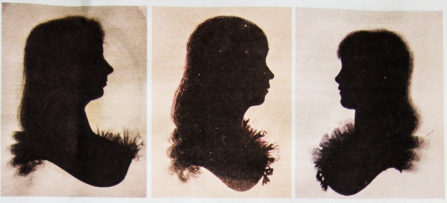 On the left is an unknown girl illustrated in the Book on page 649 ills.1258. Note her sloping bust-line that is especially associated with Houghton’s work.
On the left is an unknown girl illustrated in the Book on page 649 ills.1258. Note her sloping bust-line that is especially associated with Houghton’s work.
In the centre the work is said to be of a boy although he looks more like a girl to me! He is ex. Desmond Coke Collection and was sold at his Sale on 22nd July 1931. Also, he is illustrated in Desmond Coke’s book entitled ‘Confessions of an Incurable Collector” plate 5 facing page 18. It is a nice silhouette but I do not think the frills at the front are shirt frills!
On the right is Mary McCloud, who was sold at Bonhams on 2nd December 200 lot 20. Interestingly she made £600 on the hammer. She is a very attractive example of Houghton’s work. Note especially Houghton’s treatment of curls - generally these ‘cover’ the sharp point at the back of the bust-line termination.
S. Houghton’s work on ivory.
 Unfortunately I do not own any jewellery or work on ivory by Houghton - so my illustrated examples are from catalogues and the literature. Most of these I have been able to find are of children - however, I did find two lockets of men, but I have to confess that both looked very like the work of Miers. Fortunately Houghton generally did sign these works under the bust-line.
Unfortunately I do not own any jewellery or work on ivory by Houghton - so my illustrated examples are from catalogues and the literature. Most of these I have been able to find are of children - however, I did find two lockets of men, but I have to confess that both looked very like the work of Miers. Fortunately Houghton generally did sign these works under the bust-line.
On the left is a man mounted in a bracelet clasp and sold at the Shirley North Sale on 14th June 2000, lot 13.
On the right is a young girl mounted in a locket and sold at Sotheby's on 17th. December 1973, lot 19. On her reverse is coiled hair under white opaque glass. Size oval 3". Many pieces by Houghton had this ‘format' at the back.
Houghton page 6
More work on plaster
 At the top and in the centre on the right are a brother and sister - both have been illustrated several times in the literature. A certain amount of information is known about the 'sitters' and both are now part of the Victoria & Albert Museum Collection. The girl is called Elizabeth Steuart - she was born in 1773 and is probably about 11 years old when she was painted. She is illustrated in the Book Costume Section on page 163 illus. 240. Her brother is called James Steuart - he was born in 1776 and was probably about 9 when painted. He is illustrated in the Book on page 698 illus. 1485. Also, both are illustrated in Arthur Mayne's "British Profile Miniaturists" from where I have taken these illustrations. Both are easily recognised as works by Houghton.
At the top and in the centre on the right are a brother and sister - both have been illustrated several times in the literature. A certain amount of information is known about the 'sitters' and both are now part of the Victoria & Albert Museum Collection. The girl is called Elizabeth Steuart - she was born in 1773 and is probably about 11 years old when she was painted. She is illustrated in the Book Costume Section on page 163 illus. 240. Her brother is called James Steuart - he was born in 1776 and was probably about 9 when painted. He is illustrated in the Book on page 698 illus. 1485. Also, both are illustrated in Arthur Mayne's "British Profile Miniaturists" from where I have taken these illustrations. Both are easily recognised as works by Houghton.
At the bottom on the right is an unknown girl sold at Sotheby's on l6th September 1982, lot 457. She is signed under the bust-line and housed in a silver gilt locket with her monogram and coil of hair on her reverse. The two girls on this page both have the typical elongated sloping bust-line used by Houghton.
Works on plaster backed by the Houghton & Bruce trade label
The partnership between the two men lasted for only four years from 1792 to 1796. So works backed by the joint label are comparatively rare. There will be works painted on ivory during the partnership, but as these are not labeled, attribution can only be made on a signature or on technical details. Mrs. McK. illustrates four silhouettes in her Book backed with the joint label. She is certain that two are by the "mature Houghton" and two by the "much younger Bruce". I cannot be so sure about the examples I am using for illustration on the next page.
Unfortunately I have no works backed with this label - I am always hoping that I will acquire one at some point but I am not hopeful! Therefore, I am only illustrating works that seem in my view to be by Houghton on stylistic grounds. Mrs. McK. has some magnification photographs in Section Four, which she states distinguish the different styles of the two artists - I have looked carefully at these but I still cannot feel confidant!
Works with this label will almost certainly be housed in turned pearwood frames with or without a verre eglomise border. However, there is an example in the Victoria & Albert Museum Collection is housed in a pressed brass frame. The label stresses the partnership's work on ivory, so it can be presumed that the main focus of their work was on this medium. Bruce's skills as a jeweller will have been very useful.
Houghton page 7
Men
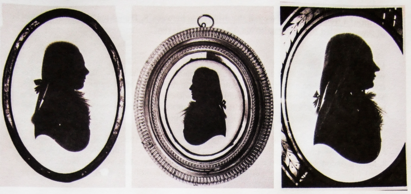 On the left is an unknown man sold at Bonhams on 21st February 1996, lot 16. He is housed in a pearwood frame with Houghton's special version of a verre eglomise inset - this is not possible to see fully.
On the left is an unknown man sold at Bonhams on 21st February 1996, lot 16. He is housed in a pearwood frame with Houghton's special version of a verre eglomise inset - this is not possible to see fully.
In the centre is a man from the Victoria & Albert Museum Collection. He is in the Book on page 650 illus. 1263, and in "Silhouettes" by Mrs. Peggy Hickman. I think his verre eglomise surround has been added at some point, as it is somewhat amateurish!
On the right is yet another unknown man ex. Christie Collection. He is illustrated in the Book on page 650 illus. 1262 and was sold at Bonhams on 22nd. February 2005, lot 31. The fact that so many of the examples I have illustrated in this article are either in the Book or have been used by other writers on the subject I think shows that there are not many of Houghton's works around.
Women
 On the left a lady from the Martin Willcocks Sale at Bonhams on 10th November 1998, lot 110. It is rather a plain example for this joint label - looks like an early Miers! It has an addition on the label, which I will mention later under LABELS.
On the left a lady from the Martin Willcocks Sale at Bonhams on 10th November 1998, lot 110. It is rather a plain example for this joint label - looks like an early Miers! It has an addition on the label, which I will mention later under LABELS.
In the centre and on the right are two women sold at Bonhams on 22nd. February, 2005. Lot 24 is of a showy lady - unfortunately she was housed in a somewhat tatty frame, but she did sell on the day. Unlike her companion lot 30, which did not reach its reserve - this was a little surprising. However, she did sell at a later date for a rather poor price. I cannot remember why she did not do better backed with this rare label.
Houghton page 8
Without a trade label, can we tell the difference between S. Houghton's work from that of those painted by J. Miers, during his travelling period?
I have found this question very difficult to answer! The more I have looked at Houghton's work and compared it with that of Miers of the same period the more uncertain I have become that I would be able to make a 'correct' attribution. As I have mentioned earlier Mrs. McK. was quite confident that she could do so - although I have noticed that other writers have not been so up beat! However, Mrs. McK did concede that Houghton's work was somewhat difficult to distinguish from Mier’s pre-London output.
Nevertheless, I will go through the main distinctions that Mrs. McK. made. For the purposes of this exercise I will only illustrate examples by Miers backed with trade labels nos.6,7 & 8. Mier’s London work backed with his label no.10 is in a class of its own and not to be compared in this context. Also, I am making no comparison with the work of John Field or Miers’ X work.
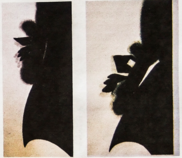 1) The peak at the back of the bustline.
1) The peak at the back of the bustline.
Houghton's peak is less sharp than that of Mier's. On the left is my Mr. Dale's peak by Houghton. On the right is Mr. Dyer's peak backed by label no. 8. Certainly these examples prove the point and I think generally it is a useful attribution ‘tool’.
 2 ) Treatment of queue and pigtail ribbons.
2 ) Treatment of queue and pigtail ribbons.
Generally Miers used a rhomboid shape in his bows - at times this could be (plue narrow. Houghton did not use this shape at all. On the left is from the Book page 678 illus. 1429 by Houghton. On the right is also from the Book on page 678 illus. 1432 by Miers. Shadowing of the pigtails was used by both men but more consistently by Miers. Leaching of the paint to form a beige outline is not seen in Houghton’s work whereas it is frequently seen on early Miers.
Houghton page 9
More Houghton V. Miers
3) Hair and Ribbons
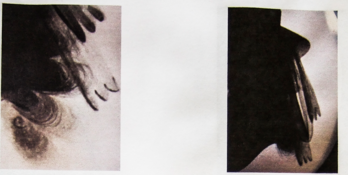 Mrs. McK. states that the ends of women's hair tended to be "smudged" by Houghton, whereas Miers showed their hair with much finer lines. Also she stated, that ribbons were painted differently by the two artists. Above are two examples by Houghton in enlarged detail.
Mrs. McK. states that the ends of women's hair tended to be "smudged" by Houghton, whereas Miers showed their hair with much finer lines. Also she stated, that ribbons were painted differently by the two artists. Above are two examples by Houghton in enlarged detail.
On the left is Frances Yates again from the Book page 677 illus. 1421. Certainly her curls are somewhat cursory and 'detached' and ribbons are not fully outlined. On the right is a detail from the lady in riding costume - what is depicted of her hair is a little straggly and her ribbons are rather pale. Below are two examples from Mr. Miers.
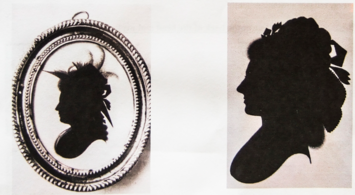 Desmond Coke suggested that Miers treatment of hair was 'tighter' than that of Houghton. However, I have found this difficult to show and the Book does not seem to have any suitable enlarged illustrations. On the left is a lady backed by trade label no. 8 dated 1787 and illustrated in the Book on page 659 illus. 1318. Her hair is certainly 'tighter' and her ribbons darker. On the right is a lady from Morgan Mais "A Master of Silhouette" on plate 17 of Mrs. Elizabeth Lodge. She illustrates the same points. Obviously I have used examples that try to make the case, but in the process I have found other examples that do not. However, I think on the whole Miers was a `neater operator' in his painting of hair and ribbons on women. This same ‘neatness' can be seen with his men.
Desmond Coke suggested that Miers treatment of hair was 'tighter' than that of Houghton. However, I have found this difficult to show and the Book does not seem to have any suitable enlarged illustrations. On the left is a lady backed by trade label no. 8 dated 1787 and illustrated in the Book on page 659 illus. 1318. Her hair is certainly 'tighter' and her ribbons darker. On the right is a lady from Morgan Mais "A Master of Silhouette" on plate 17 of Mrs. Elizabeth Lodge. She illustrates the same points. Obviously I have used examples that try to make the case, but in the process I have found other examples that do not. However, I think on the whole Miers was a `neater operator' in his painting of hair and ribbons on women. This same ‘neatness' can be seen with his men.
Houghton page 10
More Houghton V. Miers
4) Front Frills
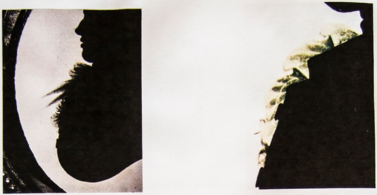 Mrs. McK suggests that before Miers went to London his shirt frills on men were less elaborate than those of Houghton, but Houghton showed a lack of finish in comparison. On the left is an enlargement from a silhouette in the Victoria & Albert Museum Collection by Houghton. The frill detail is quite elaborate but somewhat sketchy. On the right is an enlargement from a silhouette by Miers backed with trade label no. 7 - I illustrated him in a long article on Miers’ work in the July, 2001 Newsletter. Here the frill is simple but very much 'neater' than Houghton's effort. Again I am not convinced that frills are a very reliable attribution ‘tool'.
Mrs. McK suggests that before Miers went to London his shirt frills on men were less elaborate than those of Houghton, but Houghton showed a lack of finish in comparison. On the left is an enlargement from a silhouette in the Victoria & Albert Museum Collection by Houghton. The frill detail is quite elaborate but somewhat sketchy. On the right is an enlargement from a silhouette by Miers backed with trade label no. 7 - I illustrated him in a long article on Miers’ work in the July, 2001 Newsletter. Here the frill is simple but very much 'neater' than Houghton's effort. Again I am not convinced that frills are a very reliable attribution ‘tool'.
5) The Backline - ie the line at the back of the head and neck
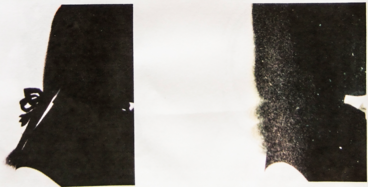 Mrs. McK. states that this line is more vertical with Miers. With Houghton it tends to be more curved and to slope forwards. Certainly this is true in the case of Mr. Ronald illustrated on the left. He is ex McKechnie Collection and used earlier in this article. He is illustrated in the Book on page 649 illus. 1259. On the right is a boy by Miers - his stance is certainly very upright, Yet again I do not think this can be regarded as a reliable `tool' as Houghton not infrequently has a straight backline on his works especially those painted on ivory.
Mrs. McK. states that this line is more vertical with Miers. With Houghton it tends to be more curved and to slope forwards. Certainly this is true in the case of Mr. Ronald illustrated on the left. He is ex McKechnie Collection and used earlier in this article. He is illustrated in the Book on page 649 illus. 1259. On the right is a boy by Miers - his stance is certainly very upright, Yet again I do not think this can be regarded as a reliable `tool' as Houghton not infrequently has a straight backline on his works especially those painted on ivory.
Houghton page 11
More Houghton V Miers
6 Bustline termination
 Mrs. McK. mentions that the forefront of the bust-line plunges deeper in the case of Houghton than that of Miers. I have found this very difficult to show as Miers varied his bust-line somewhat during the relevant period. In my view I do not think this 'tool' can be relied upon for attribution.
Mrs. McK. mentions that the forefront of the bust-line plunges deeper in the case of Houghton than that of Miers. I have found this very difficult to show as Miers varied his bust-line somewhat during the relevant period. In my view I do not think this 'tool' can be relied upon for attribution.
On the left is Master McClean by Houghton illustrated in the Book on page 649 illus. 1260. Next to him in the centre is an unknown boy by Miers, also illustrated in the Book on page 660 illus. 1324. He does show a flatter bust-line but unfortunately he is backed by trade label no.l0! On the right is a man by George Bruce, which shows an even deeper plunge on the bust-line. Bruce clearly painted showing a deeper line. This is illustrated in the Book on page 647 illus. 1246.
Houghton's trade label.
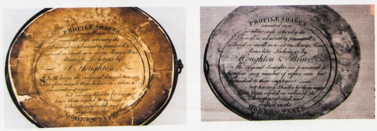 There is only one trade label recorded by Houghton when he was working on his own. This is photographed on the left above.
There is only one trade label recorded by Houghton when he was working on his own. This is photographed on the left above.
When Houghton formed his partnership with Bruce in 1792 the name BRUCE was added to the label, but the wording was not altered. This label is illustrated from Mrs. Jackson's "Dictionary" on the right above.
Two silhouettes are recorded as having some extra words on the label. These are "Paid by Houghton & Bruce". One is in the Victoria & Albert Museum Collection and the other appeared in a Bonhams Saleroom. Unfortunately, I did not view the label at the sale and I am not clear if the extra words are printed or written by hand. In any case the words do not seem very significant!
Houghton Page 12
Houghton's Frames
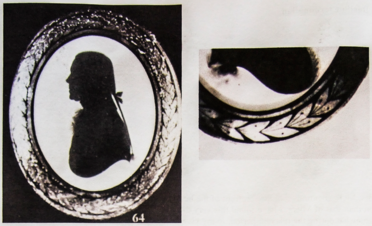 Most of Houghton's work is to be found in turned pearwood frames with or without a verre eglomise inset. Some are in pressed brass hammered frames, but these are most likely to be backed with the partnership label. As you see from above Houghton had his own special form of verre eglomise decoration. This is quite distinctive and would help to attribute his work. It is in the form of a repeated leaf pattern with a line going through both sides of the leaf ending with a dot. The man on the right above shows the format in its entirety. On the right is an enlarged detail showing the leaf pattern.
Most of Houghton's work is to be found in turned pearwood frames with or without a verre eglomise inset. Some are in pressed brass hammered frames, but these are most likely to be backed with the partnership label. As you see from above Houghton had his own special form of verre eglomise decoration. This is quite distinctive and would help to attribute his work. It is in the form of a repeated leaf pattern with a line going through both sides of the leaf ending with a dot. The man on the right above shows the format in its entirety. On the right is an enlarged detail showing the leaf pattern.
SUMMARY
As you will have gathered from this article it is my view that it is quite difficult in many instances to make a certain distinction between the work of Houghton and that of John Miers during his travelling period. However, in some instances, even without a label, it is possible to be fairly certain who is the artist - but there will always be works where the collector is hazarding a guess. Perhaps it is not all that important who is the artist provided the owner likes the silhouette and wants it to hang on the wall!
Whilst Houghton could possibly be 'accused' of imitating the great John Miers in company with Mr. Lovell and Mr. J. Smith I still think there are sufficient extant works that can be attributed to him that have their own particular charm and artistic skill for Houghton to retain his place as one of the major artists of the eighteenth century and not go down as a mere copyist.
Do let me know if any of you disagree and would like to add a comment about Houghton's work. Also, I would be interested to have photographs of works that any of you have backed by the joint Houghton & Bruce label.



















